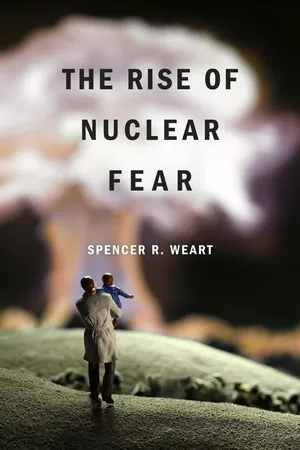
- English
- PDF
- Available on iOS & Android
The Rise of Nuclear Fear
About This Book
After a tsunami destroyed the cooling system at Japan's Fukushima Nuclear Power Plant, triggering a meltdown, protesters around the world challenged the use of nuclear power. Germany announced it would close its plants by 2022. Although the ills of fossil fuels are better understood than ever, the threat of climate change has never aroused the same visceral dread or swift action. Spencer Weart dissects this paradox, demonstrating that a powerful web of images surrounding nuclear energy holds us captive, allowing fear, rather than facts, to drive our thinking and public policy.Building on his classic, Nuclear Fear, Weart follows nuclear imagery from its origins in the symbolism of medieval alchemy to its appearance in film and fiction. Long before nuclear fission was discovered, fantasies of the destroyed planet, the transforming ray, and the white city of the future took root in the popular imagination. At the turn of the twentieth century when limited facts about radioactivity became known, they produced a blurred picture upon which scientists and the public projected their hopes and fears. These fears were magnified during the Cold War, when mushroom clouds no longer needed to be imagined; they appeared on the evening news. Weart examines nuclear anxiety in sources as diverse as Alain Resnais's film Hiroshima Mon Amour, Cormac McCarthy's novel The Road, and the television show The Simpsons.Recognizing how much we remain in thrall to these setpieces of the imagination, Weart hopes, will help us resist manipulation from both sides of the nuclear debate.
Frequently asked questions
Information
Table of contents
- Contents
- Preface
- 1. Radioactive Hopes
- 2. Radioactive Fears
- 3. Radium: Elixir or Poison?
- 4. The Secret, the Master, and the Monster
- 5. The Destroyer of Worlds
- 6. The News from Hiroshima
- 7. National Defenses
- 8. Atoms for Peace
- 9. Good and Bad Atoms
- 10. The New Blasphemy
- 11. Death Dust
- 12. The Imagination of Survival
- 13. The Politics of Survival
- 14. Seeking Shelter
- 15. Fail/Safe
- 16. Reactor Promises and Poisons
- 17. The Debate Explodes
- 18. Energy Choices
- 19. Civilization or Liberation?
- 20. Watersheds
- 21. The Second Nuclear Age
- 22. Deconstructing Nuclear Weapons
- 23. Tyrants and Terrorists
- 24. The Modern Arcanum
- 25. Artistic Transmutations
- A Personal Note
- Nuclear History Timeline
- Notes
- Further Reading
- Index